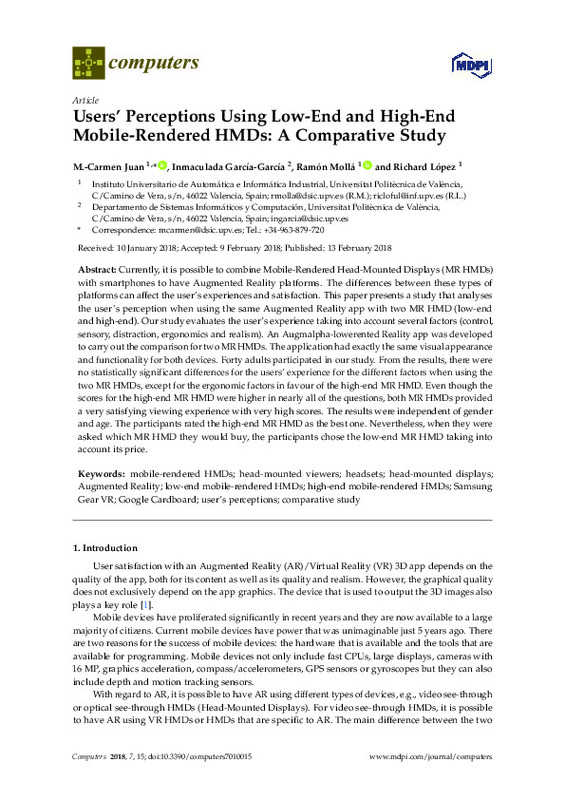JavaScript is disabled for your browser. Some features of this site may not work without it.
Buscar en RiuNet
Listar
Mi cuenta
Estadísticas
Ayuda RiuNet
Admin. UPV
Users Perceptions Using Low-End and High-End Mobile-Rendered HMDs: A Comparative Study
Mostrar el registro sencillo del ítem
Ficheros en el ítem
| dc.contributor.author | Juan, M.-Carmen
|
es_ES |
| dc.contributor.author | García García, Inmaculada
|
es_ES |
| dc.contributor.author | Mollá, R.
|
es_ES |
| dc.contributor.author | López, R.
|
es_ES |
| dc.date.accessioned | 2019-05-31T20:43:55Z | |
| dc.date.available | 2019-05-31T20:43:55Z | |
| dc.date.issued | 2018 | es_ES |
| dc.identifier.issn | 2073-431X | es_ES |
| dc.identifier.uri | http://hdl.handle.net/10251/121372 | |
| dc.description.abstract | [EN] Currently, it is possible to combine Mobile-Rendered Head-Mounted Displays (MR HMDs) with smartphones to have Augmented Reality platforms. The differences between these types of platforms can affect the user¿s experiences and satisfaction. This paper presents a study that analyzes the user¿s perception when using the same Augmented Reality app with two MR HMD (low-end and high-end). Our study evaluates the user¿s experience taking into account several factors (control, sensory, distraction, ergonomics, and realism). An Augmented Reality app was developed to carry out the comparison for two MR HMDs. The application had exactly the same visual appearance and functionality for both devices. Forty adults participated in our study. From the results, there were no statistically significant differences for the users¿ experience for the different factors when using the two MR HMDs, except for the ergonomic factors in favor of the high-end MR HMD. Even though the scores for the high-end MR HMD were higher in nearly all of the questions, both MR HMDs provided a very satisfying viewing experience with very high scores. The results were independent of gender and age. The participants rated the high-end MR HMD as the best one. Nevertheless, when they were asked which MR HMD they would buy, the participants chose the low-end MR HMD taking into account its price. | es_ES |
| dc.language | Inglés | es_ES |
| dc.publisher | MDPI AG | es_ES |
| dc.relation.ispartof | Computers | es_ES |
| dc.rights | Reconocimiento (by) | es_ES |
| dc.subject | Mobile-rendered HMDs | es_ES |
| dc.subject | Head-mounted viewers | es_ES |
| dc.subject | Headsets | es_ES |
| dc.subject | Head-mounted displays | es_ES |
| dc.subject | Augmented Reality | es_ES |
| dc.subject | Low-end mobile-rendered HMDs | es_ES |
| dc.subject | High-end mobile-rendered HMDs | es_ES |
| dc.subject | Samsung Gear VR | es_ES |
| dc.subject | Google Cardboard | es_ES |
| dc.subject | User s perceptions | es_ES |
| dc.subject | Comparative study | es_ES |
| dc.subject.classification | LENGUAJES Y SISTEMAS INFORMATICOS | es_ES |
| dc.title | Users Perceptions Using Low-End and High-End Mobile-Rendered HMDs: A Comparative Study | es_ES |
| dc.type | Artículo | es_ES |
| dc.identifier.doi | 10.3390/computers7010015 | es_ES |
| dc.rights.accessRights | Abierto | es_ES |
| dc.contributor.affiliation | Universitat Politècnica de València. Departamento de Sistemas Informáticos y Computación - Departament de Sistemes Informàtics i Computació | es_ES |
| dc.description.bibliographicCitation | Juan, M.; García García, I.; Mollá, R.; López, R. (2018). Users Perceptions Using Low-End and High-End Mobile-Rendered HMDs: A Comparative Study. Computers. 7(1):1-17. https://doi.org/10.3390/computers7010015 | es_ES |
| dc.description.accrualMethod | S | es_ES |
| dc.relation.publisherversion | http://doi.org/10.3390/computers7010015 | es_ES |
| dc.description.upvformatpinicio | 1 | es_ES |
| dc.description.upvformatpfin | 17 | es_ES |
| dc.type.version | info:eu-repo/semantics/publishedVersion | es_ES |
| dc.description.volume | 7 | es_ES |
| dc.description.issue | 1 | es_ES |
| dc.relation.pasarela | S\352736 | es_ES |








